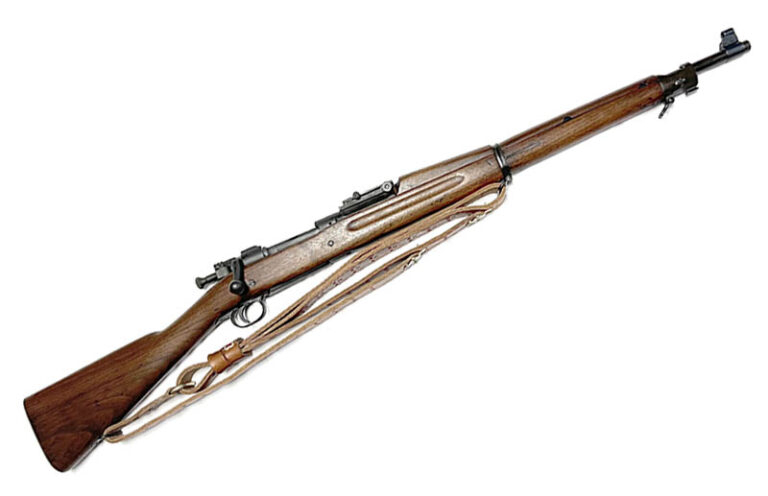
The author reviews the classic Springfield M1903 Mark 1, a historic gem still capable of producing impressive results.
The M1903 Springfield is one of those guns that just about every shooter knows, and for the most part, it needs no introduction on these pages. It’s certainly not the last bolt action rifle issued to American forces, though to truly appreciate it you must understand just how advanced this rifle was at the time it was introduced.
What follows here is the story of not just the M1903, but the significant thinking that spawned concepts we now use today. The rifle was on the edge of technological advancement in its day, and it was called to do some incredible things … including transforming into a semi-automatic, pistol-caliber rifle.
The Pretender Takes The Throne
In the turmoil and uncertainty of the late Industrial Revolution, most of the world’s great powers were in an era of colonial expansion. The threats they encountered ranged from hostile natives to forces with similar or better technology. These were the days before tanks, drones, missiles and all sorts of modern horrors. The horse and saber were still in regular use, and forces were just as likely to meet a violent end at the tip of African spears as they were machine gun fire in some places in the world.
The British were dominating entire mounted armies with just a few Maxim guns that cut down thousands of men in mere minutes. America, like the rest, sought to expand its influence into the Philippines and the Gulf of Mexico in a war against Spain. While American military intervention was likely not the best course of action against a better-prepared foe, our country went anyway and found that boldness was a bandage, not a cure, for their obvious technological shortcomings.

American forces fought against the Spanish in Cuba with the Krag rifle, a gun that was inferior in design. The Germans, Russians and British all had stripper clip-fed magazine rifles, all of which were obviously better than the slow loading, underpowered Krag and its .30-40 cartridge. The American military mind at the time was regressive; many of the officers in charge of procurement had kept the single-shot Trapdoor Springfield in .45-70 until the last minute, while European powers were already fielding belt-fed machine guns.
The Spanish had the Mauser rifle in 7mm—a cartridge that’s still theoretically relevant judging by how the 6.8 and 7mm bores are being reevaluated today. The Spanish Mauser was a wake-up call to the American military, and an immediate response was issued that demanded the same performance … and a more powerful cartridge.
And this is where things get a bit muddy. Instead of designing a totally new rifle or looking at European cartridges, the American government essentially ripped off Mauser and copied the design with a hilariously small amount of alteration. Copying someone else’s homework is usually cool with the teacher as long as you don’t write it word for word, but the American government simply didn’t care and, sure enough, they lost an international lawsuit and had to pay the Mauser company what was a fortune at the time.
To make it worse, the original cartridge, the .30-03, was an immediately outdated round-nose design, making it inferior to all the European cartridges of the time, which were all “pointed” or spitzer versions. Few .30-03 rifles exist today, and they’re very valuable: The government converted all rifles in inventory to the new .30-06 cartridge.
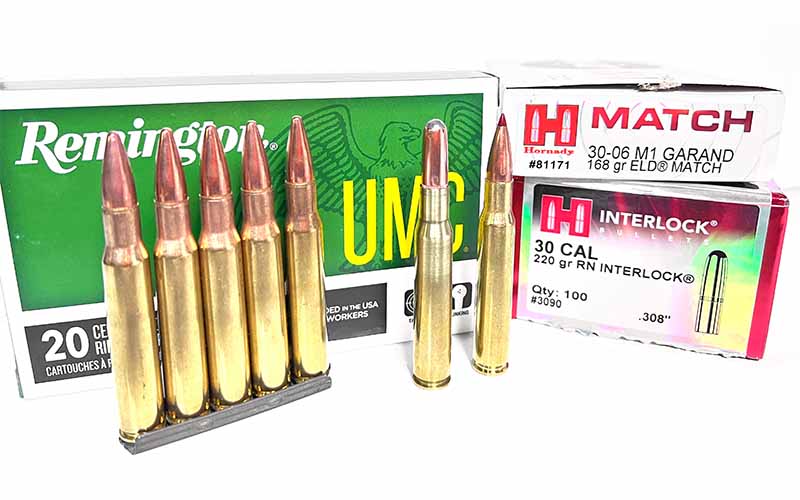

Now, with a suitably advanced bolt action, America was ready for what came next.
The prewar years were easy on the M1903. It was used in military actions, some of questionable legitimacy, in Mexico and in South America. The rifle performed very well, and the design was well known to be very accurate and lethal. This time period saw calvary troopers with bolt-action rifles, lever actions, automatic pistols, revolvers and all sorts of varied attempts to integrate these new systems.
George Patton cut his teeth in these conflicts, as did other famous names like Pancho Villa and Gen. Pershing—all deeply associated with the early history of the M1903. All this romanticism would soon end, and the era of colonial adventurism would take a sour turn as European brothers turned their new guns toward each other instead of joining forces to continue conquering the world and spreading industrial civilization.
The most “civilized” nations on Earth would rip each other to pieces and send an entire generation of young men to death in the mud. American forces entered this horror with the M1903 in hand, an already outdated rifle but with no good replacement on the horizon. Automatic rifles were the next thing, but that need wouldn’t be met until millions of lives had already been lost.
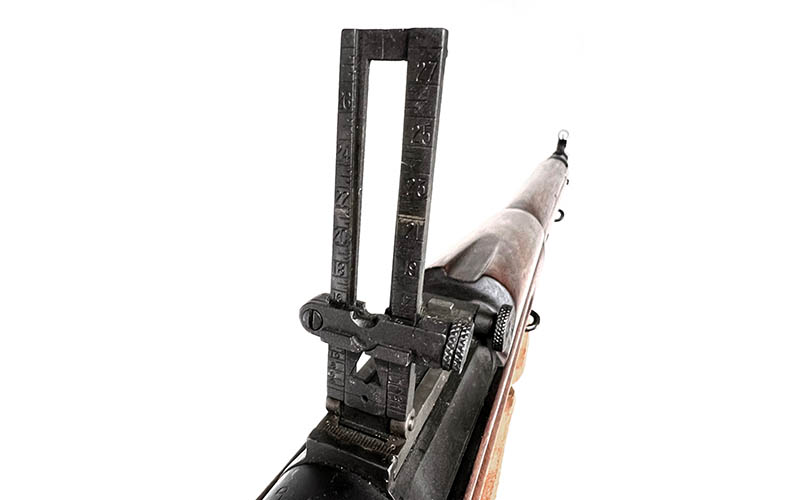

A Legacy Of Attempted Innovation
What people often fail to realize was that the M1903 was probably the most accurate, reliable and advanced bolt gun of its day, but it struggled because it largely wasn’t meant for the terrain and style of fighting that occurred in the war. The armies were uniformly armed with what amounted to target rifles geared for long-range use in open spaces.
Most of the wars fought up until this point, from an American point of view, were dynamic with high levels of movement … such as in the running battles fought in Mexico. Slow-firing, highly accurate bolt action rifles were ideal for that version fighting, but in the trenches, the rifles were used largely in frontal attacks: large artillery shells and gas were the leading cause of casualties … next to machine guns. The individual soldier was literally outgunned and had to rely on the bayonet if things got close, and close combat was a norm inside the trenches.
Variations on the M1903 began to pop up, including versions with extended magazines, suppressors and optics. These designs had been tested, and it’s believed that there were suppressed M1903 sniper rifles in use as early as 1916 in Mexico. “Periscope” rifles were also developed to safely shoot from inside a trench.


Yet, for all this, the M1903 was still a powerful bolt-action rifle, and the need to increase firepower was of utmost importance. Many designs were in the works, such as the Thompson submachine gun, but they would arrive too late to make a difference. To bridge the gap and provide the individual soldier with an appropriate weapon for all uses, the M1903 was looked at as the base for a wild concept: converting a powerful bolt-action rifle into a semi-auto, pistol-caliber rifle—with the ability to simply switch back and forth.
As strange as it sounds, this is exactly what happened.
The Pedersen Device
While it appears in video games and media occasionally, the Pedersen Device was very rare—even when it was introduced. The concept was supposedly going to be adapted to other rifles, such as the Mosin Nagant (interestingly enough, Mosin rifles were made in America as well as Russia), and it was intended to be included as a complete system for infantry rifles. This never happened, and it’s extremely unlikely that the devices ever saw combat.
The idea behind this device was that a group of soldiers could attack and defend with greater effectiveness at close distance, while at the same time being able to fight at longer ranges with full-power cartridges. Because the Springfield rifle is .30 caliber, the device used a special cartridge that originated in America, the 7.62x20mm. It’s better known by its metric designation because France actually adopted it after the war and used it well into the Vietnam era.
The idea that soldiers could hold ground better with these underpowered pistol rounds is dubious at best, but it demonstrated that there was a general need for something of an in-between cartridge that was able to be fired in rifles but had a weight savings and capacity advantage. Many attempts would be made over the next decades, until the first true intermediate rounds were developed by the Nazis with the 8x33mm for the STG44, making it the first true “assault rifle” that eventually antiquated many full-size rifles.
In the meantime, the concept of the Pedersen and its small .30-caliber cartridge led to the thinking behind the M1 Carbine and its own .30 Carbine cartridge, which proved to be a far more successful product that saw plenty of use … despite better options existing.
Since the concept was largely unviable, production ended about as soon as it began, and most Pedersen Devices were destroyed or lost to time. Surviving examples are very rare, commanding prices upward of $60,000. Rifles that were designed to use the Pedersen Device are a separate evolution of the M1903 and carry the designation “MARK 1.”
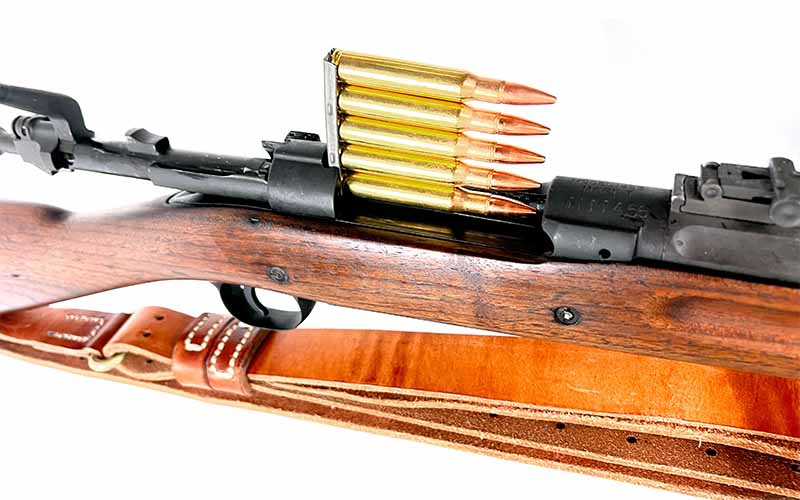

The number of Mark 1 rifles manufactured is up for some debate. Some estimates place them as high as 10 percent of total M1903 production, but in my own research and my two decades as a CMP shooter and collector, I’ve only come across one of these rifles in original, but re-arsenaled, condition … and it’s in this article.
There are definite discrepancies in the serial number ranges and apparent numbers that are on the market, and more than that, I estimate that 99 percent of these rifles had their altered parts swapped in for standard M1903 parts by the military. In other words, collecting these rifles is a crapshoot. The only real way to get close is to check for the Mark 1 stamping and, of course, the telltale ejection port cut in the left side of the receiver.
The number of these rifles available today is quite small, and their value is extremely subjective. My rifle retains most of the original parts, including the smooth Mark 1 trigger. That trigger alone is worth a good amount. I replaced it in my gun with a standard serrated M1903 trigger, knowing I was going to shoot it in CMP matches. My rifle was original and even had the original cosmoline, rust-inhibiting wax wrapper.
I bought the rifle for a song because it was encased in a hardened layer of said cosmoline, and the owner thought it was trash. I had to keep a straight face after examining it, because it was worth easily four times what I paid. The cosmo layer only took me an afternoon to remove, and I found that the rifle was in un-issued condition with a 1919-dated barrel that corresponded to the serial number, meaning it was likely this barrel was original to the receiver. Of note, the presence of a wrapper on the gun and the fact that mine has a standard “S” stock with correct acceptance stamps (no ejection port cut) proves that it was a re-arsenaled gun.


In my experience, the Mark 1 variants are exceedingly difficult to find. The receiver markings are valuable on their own, even if the rest of the rifle is unoriginal, the special receiver can add as much as $1,000 on top of the base 1903 value. My rifle in this article would sell for around $3,000 given that it retains many of the original Mark 1 small parts but has a later Parkerized finish, as opposed to the glossy black common to truly original guns. A complete rifle with original finish would be valued at somewhere around $5,000.
Now, could an enterprising man simply buy the correct small parts and add them to his Mark 1 receiver? Sure, and few would know any different because most of these guns were re-arsenaled in the interwar years, much like mine. You should exercise caution at these prices. If you’re looking for an original, it should have the straight “S” stock with two crossbolts, correct Mark 1 stamping, ejection port cut and slightly swept bolt handle. Finding rifles with original triggers designed for alternating between bolt action and semi auto are rare, and, as I mentioned, I swapped mine out to prevent it from getting damaged.
The M1903 Mark 1 In Action
It’s extremely likely that I’m the first person outside of the arsenal to fire this rifle. As a result, I’m able to fully assess what a 105-year-old rifle was truly capable of. I found that, off the bench, the Mark 1 rifle was capable of easily holding 1.5-inch groups using modern Hornady 168-grain M1 Garand match loads. For comparison, my Fulton Armory M1 rifle, essentially a new gun in all respects that matter, is capable of the same accuracy with the same ammunition. I shot both the Fulton M1 and the Mark 1 rifle at the 2023 Camp Perry National Matches and took a silver and bronze, respectively.
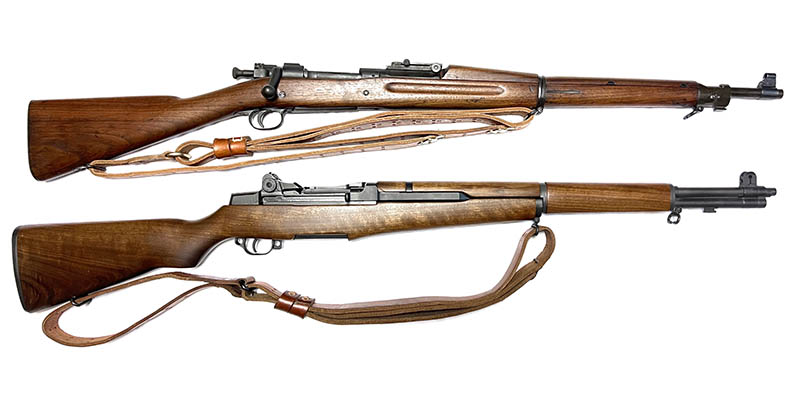

Ammunition in the 150-grain class is substantially more comfortable to fire in the Mark 1. My personal favorite is the Remington UMC load; it’s affordable and able to print groups around 2 inches for 10 shots at 100 yards. In fact, it’s my go-to load for this rifle, being that I really only shoot iron sights out to 300 yards.
I’m extremely impressed with the craftsmanship of the rifle overall, and the ammunition was the limiting factor in the day. A Camp Perry legend and record set in 1921 by Bob Farr was done with an off-the-rack M1903. He shot 71 consecutive bull’s-eyes at a staggering 1,000 yards until the coming darkness of night made him stop. This feat has never been bested, and his overall record still stands.
Editor’s Note: This article originally appeared in the March 2024 issue of Gun Digest the Magazine.
More Classic Military Guns:


Next Step: Get your FREE Printable Target Pack
Enhance your shooting precision with our 62 MOA Targets, perfect for rifles and handguns. Crafted in collaboration with Storm Tactical for accuracy and versatility.
Subscribe to the Gun Digest email newsletter and get your downloadable target pack sent straight to your inbox. Stay updated with the latest firearms info in the industry.





